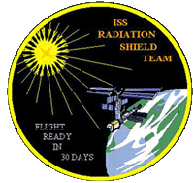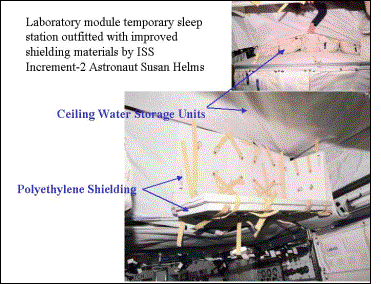

What do you do when opportunity knocks? Are you prepared? What is opportunity? What does it look like? A telephone? For Mark McDonald, a NASA engineer, opportunity is a matter of caring, preparing, and sharing. He opened the door to opportunity, and a high school student walked through it.
The story of the Christmas Bricks began on December 12, 2000. Susan Helms was scheduled to be on the ISS astronaut crew in March 2001. She was concerned that high levels of radiation could affect her ability to have healthy children. She told a colleague of Mark's, "I don't have kids yet, and I would like to make sure that in the future I have that opportunity." Mark has two kids, and he wanted to help protect Susan's future family if he could.
It usually takes two years for NASA to go from an idea to a finished product. If the team moves fast, it might take a year. Mark had to hurry. He had only one month to create a personal radiation protection system for Susan Helms. We all have had problems handed to us, sometimes problems we don't necessarily want . You know how hard it is to keep from thinking about them ALL THE TIME.
Mark big problem-how to protect Susan Helms from radiation in space-kept producing little problems. For instance, if NASA was going to use polyethylene bricks (a material that makes a great radiation shield), could they be shapes so they could be belted together to not let any radiation through the cracks? The shape of the bricks became a speed bump in the path to success. The Lego design is excellent on the flat, but not in three dimensions. The speed bump became a mental itch for Mark. It was haunting him day and night. As one day was passing into night, Mark was teaching a martial arts class. He couldn't concentrate on the the martial arts, so he decided to share his problem with his class.
Let's let Mark tell it himself: "It was early in the project. Just after I got going, as a matter of fact. When I hit a glitch, it's all I can think about. So, I was sharing this problem with my martial arts class. It had to do with how to get the bricks to fit both in a curve as well as link to form a cover over the body. It's one thing to make a tube of bricks; it's another to link an end to the tube so that there are no cracks. I'm describing this problem and I drew a picture. There's this nice young boy in class. He's 15, a B, maybe a C student, who really works hard for his grades. This was one great kid, who wasn't book-smart, but was like a bull-dog when it came to solving problems and helping people. Martial arts are all about making people feel better about themselves, and we'd been working with this kids for several years building his self-confidence by helping him learn what a great kid he really was.
"I'm describing this problem which I draw on a wall, and I ask, 'How am I going to do this?' And this kid is staring intently at my drawing and he says, "It's a telephone." I'm blank. And he says, 'look.' And he gets up, walks to the front, takes my pencil, and draws this telephone shaped brick on the wall. "
"You build an earpiece, you build a mouthpiece, and you build a handle. The bricks link together to look like a telephone," he said.
And I said, 'Oh!' And that's exactly what we ended up building. It came
from a 15-year-old boy could could see and think in three dimensions,
and describe it; and he just blurted out this idea with total commitment
to it. With that cool idea and help from a lot of people a team came up
with the ideas and the product that helped Susan Helms and possibly the
health of her future children.
Mark McDonald had an opportunity to do an important job at NASA. He had the leadership skills and confidence to share the problem with others. And others saw helping Mark as an opportunity to be a part of something bigger than them. Mark didn't stop there, either. Each person who joined in became a member of the "Christmas Bricks Mission." Take a look at the mission patch when you get a chance. And prepare for opportunity.
The NASA report on the project reads: "Thirty days from request to
delivery. Many people did not believe this task could be accomplished
both over the Christmas Holidays and in such a short time. The team delivered
all requested hardware on January 11 - on schedule, under budget and cut
hundreds of pounds off the original weight estimates while meeting all
requirements."
Johnson Space Center, Houston, TX, January 2002.
|
This picture shows how ISS astronaut Susan Helms installed the poly-brick sleep station in the U.S. Laboratory, Destiny. Also shown are bags of water in storage, used here as additional radiation protection in the temporary sleeping quarters. Picture taken in early 2000. |

